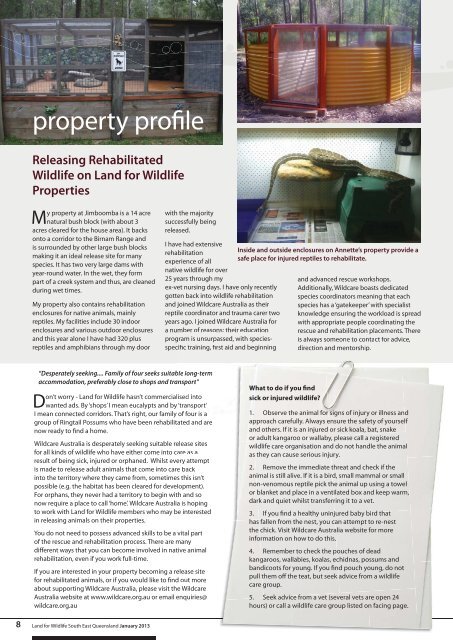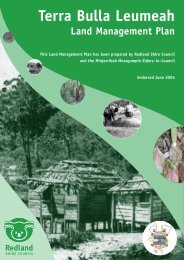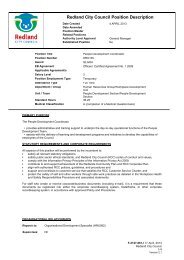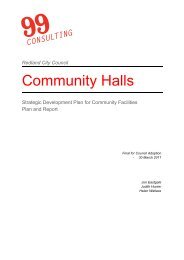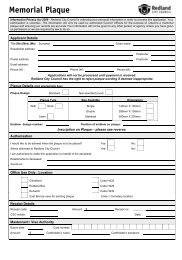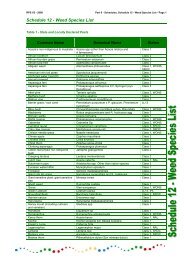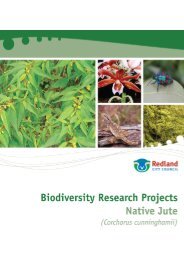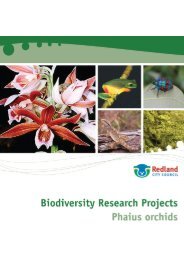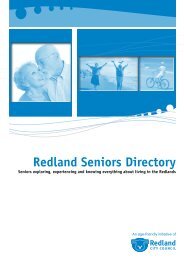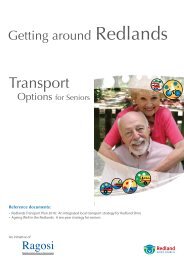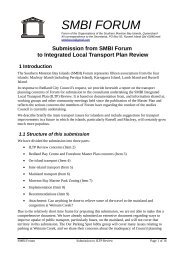Land for Wildlife Newsletter - IndigiScapes
Land for Wildlife Newsletter - IndigiScapes
Land for Wildlife Newsletter - IndigiScapes
You also want an ePaper? Increase the reach of your titles
YUMPU automatically turns print PDFs into web optimized ePapers that Google loves.
property profile<br />
Releasing Rehabilitated<br />
<strong>Wildlife</strong> on <strong>Land</strong> <strong>for</strong> <strong>Wildlife</strong><br />
Properties<br />
My property at Jimboomba is a 14 acre<br />
natural bush block (with about 3<br />
acres cleared <strong>for</strong> the house area). It backs<br />
onto a corridor to the Birnam Range and<br />
is surrounded by other large bush blocks<br />
making it an ideal release site <strong>for</strong> many<br />
species. It has two very large dams with<br />
year-round water. In the wet, they <strong>for</strong>m<br />
part of a creek system and thus, are cleaned<br />
during wet times.<br />
My property also contains rehabilitation<br />
enclosures <strong>for</strong> native animals, mainly<br />
reptiles. My facilities include 30 indoor<br />
enclosures and various outdoor enclosures<br />
and this year alone I have had 320 plus<br />
reptiles and amphibians through my door<br />
with the majority<br />
successfully being<br />
released.<br />
I have had extensive<br />
rehabilitation<br />
experience of all<br />
native wildlife <strong>for</strong> over<br />
25 years through my<br />
ex-vet nursing days. I have only recently<br />
gotten back into wildlife rehabilitation<br />
and joined Wildcare Australia as their<br />
reptile coordinator and trauma carer two<br />
years ago. I joined Wildcare Australia <strong>for</strong><br />
a number of reasons: their education<br />
program is unsurpassed, with specific training, first aid and species-<br />
beginning<br />
Inside and outside enclosures on Annette’s property provide a<br />
safe place <strong>for</strong> injured reptiles to rehabilitate.<br />
and advanced rescue workshops.<br />
Additionally, Wildcare boasts dedicated<br />
species coordinators meaning that each<br />
species has a ‘gatekeeper’ with specialist<br />
knowledge ensuring the workload is spread<br />
with appropriate people coordinating the<br />
rescue and rehabilitation placements. There<br />
is always someone to contact<br />
ct<br />
<strong>for</strong> advice,<br />
direction and mentorship.<br />
“Desperately seeking.... Family of four seeks suitable long-term<br />
accommodation, preferably close to shops and transport”<br />
Don’t worry - <strong>Land</strong> <strong>for</strong> <strong>Wildlife</strong> hasn’t commercialised e into<br />
wanted ads. By ‘shops’ I mean eucalypts and by ‘transport’<br />
t’<br />
I mean connected corridors. That’s right, our family of four is a<br />
group of Ringtail Possums who have been rehabilitated and are<br />
now ready to find a home.<br />
Wildcare Australia is desperately seeking suitable release sites<br />
<strong>for</strong> all kinds of wildlife who have either come into care as a<br />
result of being sick, injured or orphaned. Whilst every ery attempt<br />
is made to release adult animals that come into care back<br />
into the territory where they came from, sometimes s<br />
this isn’t<br />
possible (e.g. the habitat has been cleared <strong>for</strong> development).<br />
For orphans, they never had a territory to begin with and so<br />
now require a place to call ‘home’. Wildcare Australia a is hoping<br />
to work with <strong>Land</strong> <strong>for</strong> <strong>Wildlife</strong> members who may be<br />
interested<br />
in releasing animals on their properties.<br />
You do not need to possess advanced skills to be a vital part<br />
of the rescue and rehabilitation process. There are many<br />
different ways that you can become involved in native animal<br />
rehabilitation, even if you work full-time.<br />
If you are interested in your property becoming a release site<br />
<strong>for</strong> rehabilitated animals, or if you would like to find out more<br />
about supporting Wildcare Australia, please visit the Wildcare<br />
Australia website at www.wildcare.org.au or email enquiries@<br />
wildcare.org.au<br />
What to do if you find<br />
sick or injured wildlife?<br />
1. Observe the animal <strong>for</strong> signs of injury or illness and<br />
approach carefully. Always ensure the safety of yourself<br />
and others. If it is an injured or sick koala, bat, snake<br />
or adult kangaroo or wallaby, please call a registered<br />
wildlife care organisation and do not handle the animal<br />
as they can cause serious injury.<br />
2. Remove the immediate threat and check if the<br />
animal is still alive. If it is a bird, small mammal or small<br />
non-venomous reptile pick the animal up using a towel<br />
or blanket and place in a ventilated box and keep warm,<br />
dark and quiet whilst transferring it to a vet.<br />
3. If you find a healthy uninjured baby bird that<br />
has fallen from the nest, you can attempt to re-nest<br />
the chick. Visit Wildcare Australia website <strong>for</strong> more<br />
in<strong>for</strong>mation on how to do this.<br />
4. Remember to check the pouches of dead<br />
kangaroos, wallabies, koalas, echidnas, possums and<br />
bandicoots <strong>for</strong> young. If you find pouch young, do not<br />
pull them off the teat, but seek advice from a wildlife<br />
care group.<br />
5. Seek advice from a vet (several vets are open 24<br />
hours) or call a wildlife care group listed on facing page.<br />
8<br />
<strong>Land</strong> <strong>for</strong> <strong>Wildlife</strong> South East Queensland January 2013


